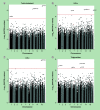Early pregnancy dyslipidemia is associated with placental DNA methylation at loci relevant for cardiometabolic diseases
- PMID: 32677467
- PMCID: PMC7466909
- DOI: 10.2217/epi-2019-0293
Early pregnancy dyslipidemia is associated with placental DNA methylation at loci relevant for cardiometabolic diseases
Abstract
Aim: To identify placental DNA methylation changes that are associated with early pregnancy maternal dyslipidemia. Materials & methods: We analyzed placental genome-wide DNA methylation (n = 262). Genes annotating differentially methylated CpGs were evaluated for gene expression in placenta (n = 64). Results: We found 11 novel significant differentially methylated CpGs associated with high total cholesterol, low-density lipoprotein cholesterol and triglycerides, and low high-density lipoprotein cholesterol. High triglycerides were associated with decreased methylation of cg02785814 (ALX4) and decreased expression of ALX4 in placenta. Genes annotating the differentially methylated CpGs play key roles in lipid metabolism and were enriched in dyslipidemia pathways. Functional annotation found cis-methylation quantitative trait loci for genetic loci in ALX4 and EXT2. Conclusion: Our findings lend novel insights into potential placental epigenetic mechanisms linked with maternal dyslipidemia. Trial Registration: ClinicalTrials.gov, NCT00912132.
Keywords: cardiometabolic diseases; dyslipidemia; epigenome-wide association study; lipids; placental DNA methylation; placental gene expression.
Conflict of interest statement
This research was supported by the Intramural Research Program of the Eunice Kennedy Shriver National Institute of Child Health and Human Development, National Institutes of Health including American Recovery and Reinvestment Act funding via contract numbers HHSN275200800013C; HHSN275200800002I; HHSN27500006; HHSN275200800003IC; HHSN275200800014C; HHSN275200800012C; HHSN275200800028C; HHSN275201000009C and HHSN27500008. Additional support was obtained from the NIH Office of the Director, the National Institute on Minority Health and Health Disparities and the National Institute of Diabetes and Digestive and Kidney Diseases. The authors have no other relevant affiliations or financial involvement with any organization or entity with a financial interest in or financial conflict with the subject matter or materials discussed in the manuscript apart from those disclosed.
No writing assistance was utilized in the production of this manuscript.
Figures
Similar articles
-
Epigenetic Patterns in Blood Associated With Lipid Traits Predict Incident Coronary Heart Disease Events and Are Enriched for Results From Genome-Wide Association Studies.Circ Cardiovasc Genet. 2017 Jan;10(1):e001487. doi: 10.1161/CIRCGENETICS.116.001487. Circ Cardiovasc Genet. 2017. PMID: 28213390 Free PMC article.
-
DNA methylation loci in placenta associated with birthweight and expression of genes relevant for early development and adult diseases.Clin Epigenetics. 2020 Jun 3;12(1):78. doi: 10.1186/s13148-020-00873-x. Clin Epigenetics. 2020. PMID: 32493484 Free PMC article. Clinical Trial.
-
Placental DNA methylation changes associated with maternal prepregnancy BMI and gestational weight gain.Int J Obes (Lond). 2020 Jun;44(6):1406-1416. doi: 10.1038/s41366-020-0546-2. Epub 2020 Feb 18. Int J Obes (Lond). 2020. PMID: 32071425 Free PMC article.
-
Distinctive aspects of the placental epigenome and theories as to how they arise.Cell Mol Life Sci. 2022 Oct 26;79(11):569. doi: 10.1007/s00018-022-04568-9. Cell Mol Life Sci. 2022. PMID: 36287261 Free PMC article. Review.
-
Placental DNA methylation in pregnancies complicated by maternal diabetes and/or obesity: State of the art and research gaps.Epigenetics. 2022 Dec;17(13):2188-2208. doi: 10.1080/15592294.2022.2111755. Epub 2022 Sep 5. Epigenetics. 2022. PMID: 35950598 Free PMC article. Review.
Cited by
-
Hyperlipidemia and risk for preclampsia.J Clin Lipidol. 2022 May-Jun;16(3):253-260. doi: 10.1016/j.jacl.2022.02.005. Epub 2022 Feb 20. J Clin Lipidol. 2022. PMID: 35260347 Free PMC article. Review.
-
Methylome-wide studies of six metabolic traits.medRxiv [Preprint]. 2024 May 29:2024.05.29.24308103. doi: 10.1101/2024.05.29.24308103. medRxiv. 2024. PMID: 38853823 Free PMC article. Preprint.
-
Genomic study of maternal lipid traits in early pregnancy concurs with four known adult lipid loci.J Clin Lipidol. 2023 Jan-Feb;17(1):168-180. doi: 10.1016/j.jacl.2022.10.013. Epub 2022 Nov 17. J Clin Lipidol. 2023. PMID: 36443208 Free PMC article.
-
Placental Gene Co-expression Network for Maternal Plasma Lipids Revealed Enrichment of Inflammatory Response Pathways.Front Genet. 2021 Oct 21;12:681095. doi: 10.3389/fgene.2021.681095. eCollection 2021. Front Genet. 2021. PMID: 34745199 Free PMC article.
-
DNA methylation-based predictors of health: applications and statistical considerations.Nat Rev Genet. 2022 Jun;23(6):369-383. doi: 10.1038/s41576-022-00465-w. Epub 2022 Mar 18. Nat Rev Genet. 2022. PMID: 35304597 Review.
References
-
- Kitajima M, Oka S, Yasuhi I, Fukuda M, Rii Y, Ishimaru T. Maternal serum triglyceride at 24–32 weeks' gestation and newborn weight in nondiabetic women with positive diabetic screens. Obstet. Gynecol. 97(5 Pt 1), 776–780 (2001). - PubMed
-
- Vrijkotte TG, Algera SJ, Brouwer IA, Van Eijsden M, Twickler MB. Maternal triglyceride levels during early pregnancy are associated with birth weight and postnatal growth. J. Pediatr. 159(5), 736–742 e731 (2011). - PubMed
-
• Reports that babies born to mothers with the highest triglycerides level had higher birth weight, while babies born to mother with lowest triglycerides levels were smaller at birth but had accelerated postnatal growth.
-
- Vrijkotte TG, Krukziener N, Hutten BA, Vollebregt KC, Van Eijsden M, Twickler MB. Maternal lipid profile during early pregnancy and pregnancy complications and outcomes: the ABCD study. J. Clin. Endocrinol. Metab. 97(11), 3917–3925 (2012). - PubMed
-
- Clausen T, Burski TK, Oyen N, Godang K, Bollerslev J, Henriksen T. Maternal anthropometric and metabolic factors in the first half of pregnancy and risk of neonatal macrosomia in term pregnancies. a prospective study. Eur. J. Endocrinol. 153(6), 887–894 (2005). - PubMed
-
- Nasioudis D, Doulaveris G, Kanninen TT. Dyslipidemia in pregnancy and maternal-fetal outcome. Minerva Ginecol. 71(2), 155–162 (2019). - PubMed
Publication types
MeSH terms
Substances
Associated data
Grants and funding
LinkOut - more resources
Full Text Sources
Medical
Miscellaneous

